It is hard to overstate the impact of the slice on the game of golf. It seems that nearly every player has dealt with the slice at least once during their time as a golfer – usually shortly after taking up the game. Although the slice is an incredibly common problem for golfers to face, it remains extremely difficult to correct. Countless golf teachers have tried to come up with the ‘cure’ for the slice over the years – and most have failed.
In this article, we are going to attempt to help you overcome your slice by offering up some of the top slice tips that have been developed throughout the history of the game. Some of these tips may not apply to your swing – but one or two may be exactly what you need to get your game on track. As you review the tips below, think about your own swing to decide whether or not each individual tip is going to be something that can help you straighten out your ball flight once and for all.
Each of these tips has been written from the perspective of a right handed golfer. If you happen to play left handed, please take a moment to reverse the directions as necessary.

For a right handed golfer, strengthening the grip means turning the left hand to the right on the handle of the club at address. Making this adjustment is a great way to fight against the slice, as it will allow the club to release more easily through the hitting area. Most golfers who deal with a slice struggle to release the club properly, leaving the face open at impact and causing the ball to head well right of the target. With an improved release thanks to a stronger grip, a significant amount of the right hand spin can be taken off of your shots.
It is important to be clear on exactly what it means to use a strong grip, as many golfers confuse a strong grip with a tight grip. The ‘strength’ of your grip refers to the positioning of your hands on the club, not to how tightly you are holding onto the handle. You always want to maintain a relatively light grip pressure as you swing – just tight enough to control the club, but no tighter. During your next practice session, work on fine tuning your grip pressure until you get to a point that is comfortable and allows you to swing the club freely back and through.
If you do decide to make changes to the positioning of your hands on the club at address, remember that grip changes are some of the trickiest adjustments to make in the entire game. When you change your grip, you change everything about the way your hands and arms feel during the swing – meaning it is going to take some time to get comfortable once again. Be patient with this change and give it some time before you expect to start seeing results.
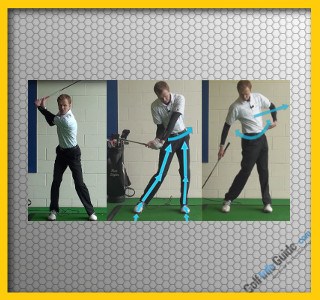
#2 – Take More Time at the Top
Many people want to get mechanical when talking about fixing their slice, but often the fix is as simple as correcting the tempo in your swing. Generally speaking, amateur golfers have lousy tempo – which is one of the main reasons they struggle to find consistency on the course. It is one thing to put yourself in great physical positions throughout the swing, but it is another thing altogether to be able to use those positions as part of a smooth, rhythmic action. When you add tempo to the equation, the whole game suddenly becomes easier.
A big part of having a great tempo in your swing is making a nice transition from backswing to downswing. This is a point that many average golfers get wrong, as they are tempted into thinking they need to rush the transition to build up as much speed as possible. That just isn’t how the swing works. You don’t need to build speed in the transition – you just need to move into a balanced downswing where you can then build speed all the way up to impact. By taking your time as you switch directions at the top, you will allow your lower body to lead the way in the downswing, which is ideal for maximizing power while still maintaining control over the club.
As you practice, think about making a slight pause at the top of your swing in order to gather up everything nicely. You won’t actually come to a stop, but simply thinking about taking a quick pause is going to be enough to keep your body well-positioned in the transition. This will likely be pretty easy on the range, but it will be quite a bit harder on the course when you start to get nervous. Before hitting any shot on the course, take a deep breath and remind yourself to take as much time as you need in the transition in order to set up a great strike.
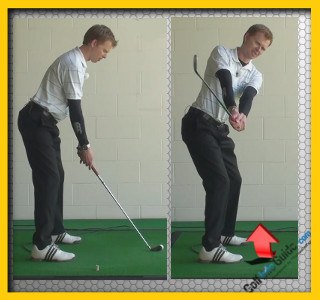
It is easy to focus on the downswing and impact itself as you deal with trying to fix your slice. After all, you are trying to take sidespin off of the ball, so it only makes sense to look at the part of the swing that is actually hitting the ball. However, many players make mistakes far earlier in their swing that wind up resulting in outside-in contact and slice spin. In fact, many slicers go wrong right from the start of the swing, as they take the club back too far to the inside and are never quite able to recover.
You might think that a mistake in the takeaway which leads to a slice would involve taking the club back too far to the outside. While that is possible, it is not usually the case. Instead, most slicers take the club back too far to the inside, which makes the backswing narrow and steep. At the top, these players push the club up and ‘over the top’, as there is no room to swing down from the inside since the backswing was so narrow. In the end, the club is too high and too far away from the body, and a slice is the inevitable outcome.
So, to work on correcting your slice, you want to focus on making a wider, straighter takeaway. Don’t let the club come in toward your body as you go back – instead, use the club head to trace a straight line back from the ball for the first foot or so. Doing this will create some width in your golf swing, and you will have the opportunity to swing down from the inside as a result.
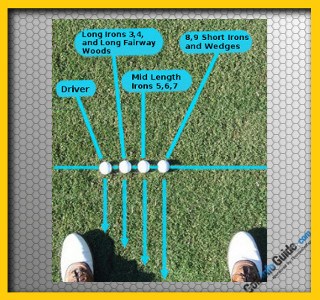
Many golfers are frustrated to learn that their struggles with the slice actually stem from something as simple as ball position. It is possible that an otherwise decent golf swing can lead to a slice when the player fails to put the ball in the right position at address, so you need to check up on this point before you get into too many other advanced changes to your technique. Most of the time, it is a ball position that is too far forward in the swing which will create slice spin.
This is a mistake that you can make with any club in the bag, but it is most likely to be seen with the driver. Putting the ball all the way up near your front foot will cause you to make impact after the club has started to move back in closer to your body – meaning the club will be contacting the ball on an outside-in path. If you make that mistake in tandem with the mistake of failing to release the club head through impact, you will wind up with a slice.
Of course, the fix here is incredibly simple. During your next visit to the driving range, test out the ball flight that results from a variety of different ball positions, and stick with the one that gives you the best results. It will probably require a bit of time and effort in order to track down that perfect ball position, but you will be happy that you invested the time when you see your slice either reduced or completely eliminated.

You might think that it is something of a cop-out to blame your clubs when you hit a slice – but it might actually be your clubs that are to blame after all. If you are using the wrong clubs for your swing, you might be destined to hit a slice even if you make a pretty good move through the ball. Specifically, clubs with shafts that are too soft for your swing speed are always going to want to hang open through impact, leading to the possibility of a slice.
To make sure you have the right clubs in your hands to avoid the slice, consider going to see a professional club fitter for a review of your current gear. For a small fee – which may be refunded if you decide to buy some clubs – the fitter will evaluate your current set and help you decide if you need to switch to different clubs in order to improve your performance. It may be that new clubs are in order, or it may be that you simply need to try a different type of shaft to straighten out your ball flight. The information that can be collected by club fitting computers today is simply amazing, and it can go a long way toward helping you play your best golf.

#6 – Swing Harder Through Impact
This is a tip that you might not expect to see, as most golf instruction usually tells you to swing softer and smoother, but there is something to be said for just turning it loose when trying to get rid of a slice. Many people who hit a slice are actually quite close to hitting a good shot, except they aren’t willing to release the club head through the hitting area. By thinking about hitting the ball as hard as you can, you will be more likely to achieve a good release – and you may get rid of your slice as a result.
The key to finding a benefit from swinging harder is that you need to maintain your balance while doing so. If you lose your balance when trying to swing hard through the ball, any benefit you might have gained will be lost. So, basically, you are trying to swing as hard as possible without losing balance. If you can give your swing plenty of power and release through the hitting area without causing yourself to fall off balance, it is likely that you will be on your way toward eliminating the slice.
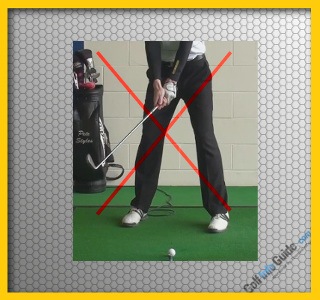
You probably don’t think that your aim has much to do with the fact that you hit a slice, but it actually can play a big role in the continuation of this problem. When you started to hit a slice, you likely began to aim out to the left of your target in order to accommodate for the left-to-right curve of your shots. Of course, this does make sense – if the ball is turning right, you need to aim left in order to have the ball wind up somewhere near the target when it comes down. However, there is a problem with this adjustment, and it has to do with how your stance influences your swing. When you aim left, you are likely to wind up in somewhat of an open position at address, which is only going to make your slice even worse. This can be a downward spiral that causes you to continue to slice the golf ball well into the future.
To avoid falling into this spiral, you need to get out of the habit of aiming to the left. Yes, when you aim directly at the target and hit a slice, your ball is going to wind up in trouble. However, when you hit good shots, you will be rewarded with a ball that flies directly for the fairway or green. Over the long run, as you work on other swing improvements which can take the slice out of your game, you will find that you play better because you are aiming right at the target instead of off to the left. Practice taking ‘dead aim’ at the driving range and then gradually put that strategy into use on the course as your slice problem fades away.

Earlier we took a look at how equipment can play a role in the slice, but that discussion was limited to your clubs. Another piece of equipment, your ball, can actually play a role in this issue as well. When you play a ball that features a spin rate which is too high for your game, you will be making your slice worse than it would be with a lower-spin ball. Unless you have the skills in place to control a high spin ball, you should always be opting to use a ball that is going to limit your spin rate to a modest level.
When talking about spin rate, most golfers think first of backspin, while forgetting that side spin is included in that rate as well. A high spin ball is going to quickly slice off to the right when contacted using an outside-in path and an open face. Playing a lower spin rate ball isn’t going to do anything to fix the mechanics of your swing, but it should make your slice more playable on the course.
How do you know which golf ball to pick? Simple – sort them by price and pick one that is in the middle of the available price range. The balls at the high end of the scale tend to have the highest spin rates, as those are meant for accomplished players with great control over their shots. If that isn’t you at this point, use a less-expensive ball which will permit you to keep your shots in play while you work on improving your technique moving forward.

#9 – Stand a Little Farther from the Ball
Crowding yourself at impact is an easy and subtle way to create a slice. In order to hit the ball while using an inside-out swing path – which is the best way to avoid the dreaded slice – you need to have room to attack the ball from the inside. If you are standing too close at address, there won’t be the necessary room between yourself and the ball and you will be forced to come through impact on an outside-in path. Just by moving back even an inch or two when setting up for your shot, you might be able to alter this path and get your swing back on track.
This is another point that is more important with the driver than it is with your irons – especially your short irons. The swing you use to hit short irons is naturally going to be more vertical, so you don’t have to worry about your path as much. Also, short iron shots rarely have enough side spin to slice, even if you hit across them from outside-in. However, with the driver, you need to make sure your position yourself just right in relationship to the ball. Standing too close with a long driver in your hands is a recipe for disaster.
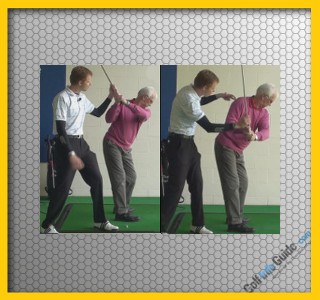
#10 – Work with a Qualified Professional
At some point, you may hit a ‘wall’ where you realize that you just aren’t going to be able to fix your slice all by yourself. Golf is an incredibly hard game, and the slice might be the single most-difficult problem of all to correct. When you slice the ball over and over again – maybe for a period of years – you will have trouble retracing your steps to get back to a point where your ball flight is relatively straight. Or, maybe you have never been able to hit straight shots, as is the case for many golfers who fight a slice right from the start.
When the slice is deeply embedded in the game you play, the best option may be to seek professional help in the way of one-on-one lessons with a teaching pro. Finding a good teaching pro in your area shouldn’t be too difficult, and most facilities offer reasonable rates for their lessons. Building a relationship with a teacher over the course of a few lessons is the best way to go as that teacher will have a chance to get to know you and your swing as they offer up ideas for how you can correct your ball flight.
Make no mistake – it is still going to be hard work to correct your slice, even with the help of a teaching pro. However, having a trained set of eyes watching your swing and correcting your mistakes should greatly speed up the learning curve. What you might have been able to figure out over the course of months could potentially be done in just weeks – or less. An experienced teacher has likely worked with hundreds of golfers who were fighting the slice, so they will know exactly what path to take in order to straighten you out once and for all.
The slice is frustrating to be sure, but it doesn’t have to be life sentence. If you are willing to put in some time and effort on eliminating this issue from your game, you can begin to lower your scores and have more fun as the slice starts to disappear. Progress is rarely quick in this challenging game, but watch for signs of improvement along the way and keep encouraging yourself to see it through to the end. Good luck!





